Tallentex 2025 - ALLEN's Talent Encouragement Exam
ApplyRegister for Tallentex '25 - One of The Biggest Talent Encouragement Exam
Heron's Formula Class 9 Questions And Answers are provided here. These NCERT solutions are created by expert team at Careers360 keeping in mind latest CBSE syllabus 2023-23. Practicing these solutions give you confidence during the exam which ultimately lead to score well in the exam. In this particular NCERT book chapter 12 maths class 9, you will learn a special technique to find the area of any triangle. NCERT Solutions for class 9 maths chapter 12 Heron's Formula is covering the explanation of all questions using Heron's formula.

Class 9 herons formula NCERT solutions are covering the solutions to each and every question present in the practice exercises in detail. If three sides of triangles are a, b, and c then the area in terms of a, b and c is given by the Heron's Formula class 9. The area is given by the formula  where s is half the perimeter. That is
where s is half the perimeter. That is . You may think about the application of Heron's Formula. This formula is used for calculating the area of irregular plots. If you have a land whose shape is not regular we will divide the plots into different triangles and then apply Heron's Formula class 9 to calculate the area. Here you will get NCERT solutions for class 9 also.
Also read:
Triangle:
Semi-perimeter of a triangle = s = (a + b + c)/2,
Where 's' is the semi-perimeter, and 'a', 'b', and 'c' are the lengths of its sides.
Area = √[s(s - a)(s - b)(s - c)]
Equilateral Triangle:
For an equilateral triangle with side length 'a':
Its perimeter is given by: Perimeter = 3a units.
The altitude (height) of an equilateral triangle is equal to √3/2 times its side length, Altitude = √3/2 * units.
The area of an equilateral triangle is equal to √3/4 times the square of its side length, Area = √3/4 * a^2 units. These formulas are specific to equilateral triangles and are based on their unique properties.
Free download NCERT Solutions for Class 9 Maths Chapter 12 Heron's Formula for CBSE Exam.
Class 9 maths chapter 12 question answer - exercise: 12.1
Answer:
Given the perimeter of an equilateral triangle is 180cm.
So, or
.
Hence, the length of the side is 60cm.
Now,
Calculating the area of the signal board by the Heron's Formula:
Where, s is the half-perimeter of the triangle and a, b and c are the sides of the triangle.
Therefore,
as it is an equilateral triangle.
Substituting the values in the Heron's formula, we obtain
.
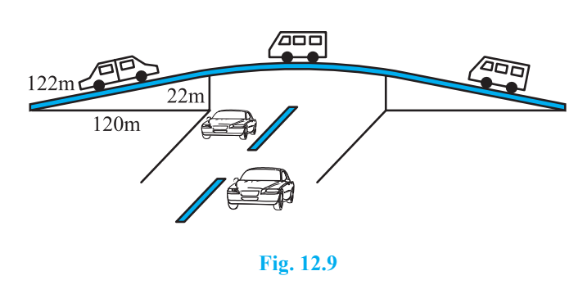 Answer:
Answer:
From the figure,
The sides of the triangle are:
The semi perimeter, s will be
Therefore, the area of the triangular side wall will be calculated by the Heron's Formula,
Given the rent for 1 year (i.e., 12 months) per meter square is Rs. 5000.
Rent for 3 months per meter square will be:
Therefore, for 3 months for 1320 m 2 :
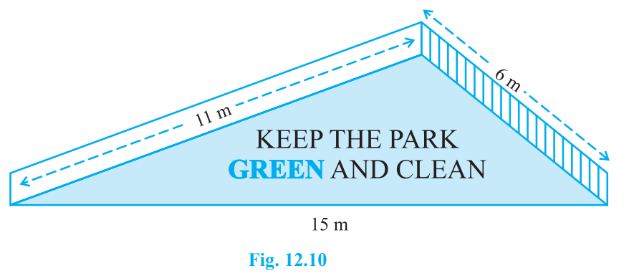 Answer:
Answer:
Given the sides of the triangle are:
So, the semi perimeter of the triangle will be:
Therefore, Heron's formula will be:
Hence, the area painted in colour is .
Q4 Find the area of a triangle two sides of which are 18cm and 10cm and the perimeter is 42cm.
Answer:
Given the perimeter of the triangle is and the sides length
and
So,
Or,
So, the semi perimeter of the triangle will be:
Therefore, the area given by the Heron's Formula will be,
Hence, the area of the triangle is
Q5 Sides of a triangle are in the ratio of 12 : 17 : 25 and its perimeter is 540cm. Find its area.
Answer:
Given the sides of a triangle are in the ratio of and its perimeter is
Let us consider the length of one side of the triangle be
Then, the remaining two sides are and
So, by the given perimeter, we can find the value of x:
So, the sides of the triangle are:
So, the semi perimeter of the triangle is given by
Therefore, using Heron's Formula, the area of the triangle is given by
Hence, the area of the triangle is .
Answer:
The perimeter of an isosceles triangle is 30 cm (Given).
The length of the sides which are equal is12 cm.
Let the third side length be 'a cm'.
Then,
So, the semi-perimeter of the triangle is given by,
Therefore, using Herons' Formula, calculating the area of the triangle
Hence, the area of the triangle is
Class 9 maths chapter 12 NCERT solutions - exercise : 12.2
Q1 A park, in the shape of a quadrilateral ABCD, has ,
,
,
and
. How much area does it occupy?
Answer:
From the figure:
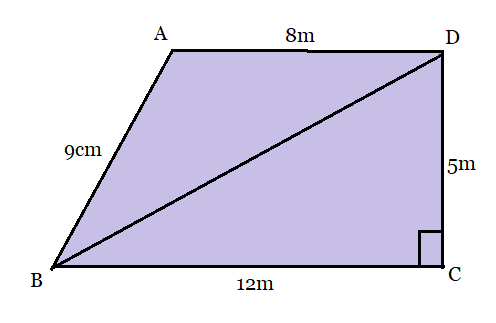
We have joined the BD to form two triangles so that the calculation of the area will be easy.
In triangle BCD, by Pythagoras theorem
The area of triangle BCD can be calculated by,
and the area of the triangle DAB can be calculated by Heron's Formula:
So, the semi-perimeter of the triangle DAB,
Therefore, the area will be:
where, .
(Approximately)
Then, the total park area will be:
Hence, the total area of the park is
Answer:
From the figure:
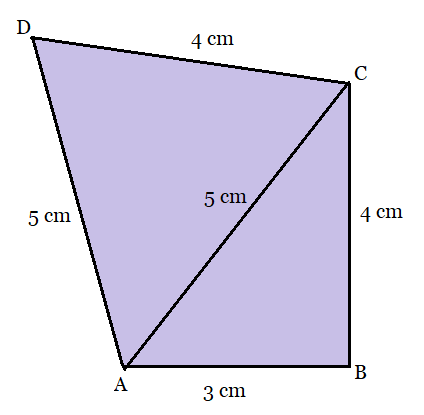
We have joined the AC to form two triangles so that the calculation of the area will be easy.
The area of the triangle ABC can be calculated by Heron's formula:
So, the semi-perimeter, where
Heron's Formula for calculating the area:
And the sides of the triangle ACD are
So, the semi-perimeter of the triangle:
Therefore, the area will be given by, Heron's formula
.
Then, the total area of the quadrilateral will be:
Hence, the area of the quadrilateral ABCD is
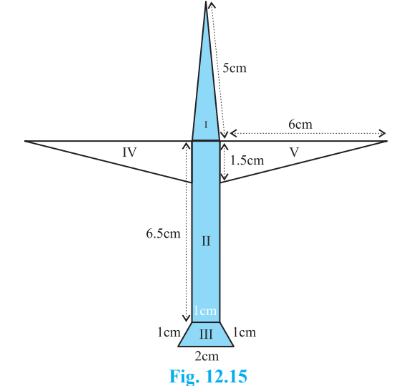 Answer:
Answer:
The total area of the paper used will be the sum of the area of the sections I, II, III, IV, and V. i.e.,
For section I:
Here, the sides are
So, the Semi-perimeter will be:
Therefore, the area of section I will be given by Heron's Formula,
For section II:
Here the sides of the rectangle are and
Therefore, the area of the rectangle is
For section III:
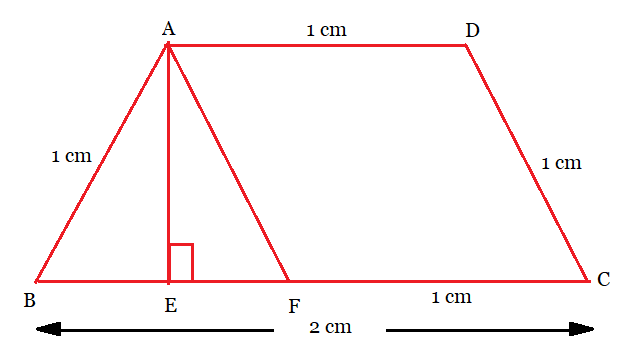
From the figure:
Drawing the parallel line AF to DC and a perpendicular line AE to BC.
We have the quadrilateral ADCF,
...........................by construction.
...........................[
ABCD is a trapezium]
So, ADCF is a parallelogram.
Therefore, and
Therefore,
ABF is an equilateral triangle.
Then, the area of the equilateral triangle ABF is given by:
Hence, the area of trapezium ABCD will be:
For Section IV:
Here, the base is 1.5 cm and the height is 6 cm.
Therefore, the area of the triangle is :
For section V:
The base length = 1.5cm and the height is 6cm.
Therefore, the area of the triangle will be:
Hence, the total area of the paper used will be:
Answer:
From the figure:
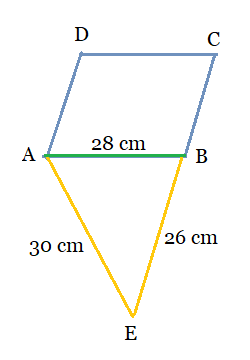 The sides of the triangle are
The sides of the triangle are
Then, calculating the area of the triangle:
So, the semi-perimeter of triangle ABE,
Therefore, its area will be given by the Heron's formula:
Given that the area of the parallelogram is equal to the area of the triangle:
Hence, the height of the parallelogram is 12 cm.
Answer:
To find the area of the rhombus:
We first join the diagonal AC of quadrilateral ABCD. (See figure)
 Here, the sides of triangle ABC are,
Here, the sides of triangle ABC are,
So, the semi-perimeter of the triangle will be:
Therefore, the area of the triangle given by the Heron's formula,
Hence, the area of the quadrilateral will be:
Therefore, the area grazed by each cow will be given by,
 Answer:
Answer:
The sides of the triangle are:
So, the semi-perimeter of the triangle is given by,
Therefore, the area of the triangle can be found by using Heron's formula:
Now, for the 10 triangular pieces of cloths, the area will be,
Hence, the area of cloths of each colour will be:
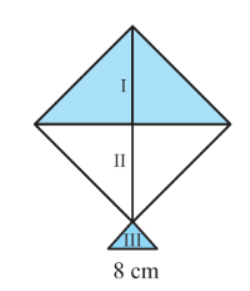 Answer:
Answer:
From the figure:
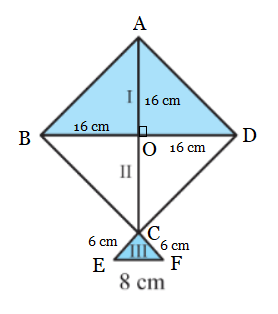 Calculation of the area for each shade:
Calculation of the area for each shade:
The shade I: Triangle ABD
Here, base and the height
Therefore, the area of triangle ABD will be:
Hence, the area of paper used in shade I is
Shade II: Triangle CBD
Here, base and height
Therefore, the area of triangle CBD will be:
Hence, the area of paper used in shade II is
Shade III: Triangle CEF
Here, the sides are of lengths,
So, the semi-perimeter of the triangle:
Therefore, the area of the triangle can be found by using Heron's formula:
Hence, the area of the paper used in shade III is .
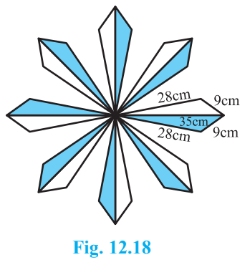 Answer:
Answer:
GIven the sides of the triangle are:
So, its semi-perimeter will be:
Therefore, the area of the triangle using Heron's formula is given by,
So, we have the area of each triangle tile which is .
Therefore, the area of each triangular 16 tiles will be:
Hence, the cost of polishing the tiles at the rate of 50 paise per cm 2 will be:
Answer:
The trapezium field is shown below in figure:
Drawing line CF parallel to AD and a line perpendicular to AB, we obtain
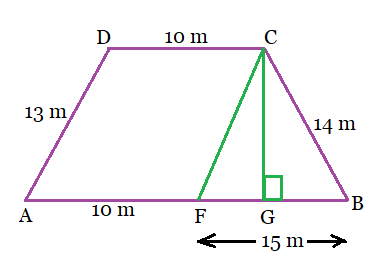 Then in quadrilateral ADCF,
Then in quadrilateral ADCF,
............................
............................
Therefore, ADCF is a parallelogram.
So, and
Therefore,
Now, the sides of the triangle;
So, the semi-perimeter of the triangle will be:
Therefore, the area of the triangle can be found by using Heron's Formula:
Also, the area of the triangle is given by,
Or,
Therefore, the area of the trapezium ABCD is:
Hence, the area of the trapezium field is
Chapter 12 of Class 9 Maths, "Heron’s Formula," is part of Unit 5: Mensuration, which carries a weightage of 13 marks out of 100 in the examination. Due to this, it is an essential chapter that requires thorough study. The chapter covers critical topics, including the area of a triangle using Heron’s formula and the application of Heron’s formula in finding areas of quadrilaterals. Heron's formula is used to calculate the area of a triangle using its three side lengths. Students who are interested in class 9 maths ch 12 question answer, can practice exercise using link given below.
Chapter No. | Chapter Name |
Chapter 1 | |
Chapter 2 | |
Chapter 3 | |
Chapter 4 | |
Chapter 5 | |
Chapter 6 | |
Chapter 7 | |
Chapter 8 | |
Chapter 9 | |
Chapter 10 | |
Chapter 11 | |
Chapter 12 | Heron’s Formula |
Chapter 13 | |
Chapter 14 | |
Chapter 15 |
Comprehensive coverage: The maths chapter 12 class 9 solutions provide complete coverage of the chapter's topics, including the derivation and application of Heron's formula for finding the area of a triangle and quadrilaterals.
Easy-to-understand language: The ch 12 maths class 9 solutions use simple and easy-to-understand language, making it easier for students to comprehend the mathematical concepts and solve problems.
Helps in scoring good marks: Practising these herons formula class 9 solutions can greatly enhance a student's chances of scoring well in their exams, as the solutions provide a comprehensive understanding of the chapter's concepts.
How to use NCERT solutions for class 9 maths chapter 12 Heron's Formula?
Keep working hard and happy learning!
Also Check NCERT Books and NCERT Syllabus here:
Area of a Triangle – by Heron’s Formula and Application of Heron’s Formula in finding Areas of Quadrilaterals are two important topics of this chapter. Students can prioritize important topics from the NCERT syllabus and study accordingly to score well in exams. for ease you can study heron's formula class 9 pdf both online and offline mode.
Here are the rephrased key benefits of NCERT Solutions for Class 9 Maths Chapter 12:
The solutions for each exercise within the chapter are easily accessible for students to refer to.
The solutions are designed with graphs and illustrations that aid in providing a clear understanding of the mathematical concepts.
The solutions are meticulously prepared by the expert team at Careers360, with a strong emphasis on accuracy.
NCERT solutions are helpful for the students if they are no able to solve NCERT problems on their own. Also, these solutions are provided in a very detailed manner which will give them conceptual clarity.
Here you will get the detailed NCERT solutions for class 9 maths by clicking on the link. Practicing these solutions will give you in-depth understanding of concepts which help you to score good marks in the exam.
Late Fee Application Date:22 July,2024 - 31 July,2024
Late Fee Application Date:22 July,2024 - 31 July,2024

Register for Tallentex '25 - One of The Biggest Talent Encouragement Exam

Get up to 90% scholarship on NEET, JEE & Foundation courses

As per latest 2024 syllabus. Physics formulas, equations, & laws of class 11 & 12th chapters

As per latest 2024 syllabus. Chemistry formulas, equations, & laws of class 11 & 12th chapters

Accepted by more than 11,000 universities in over 150 countries worldwide

Register now for PTE & Save 5% on English Proficiency Tests with ApplyShop Gift Cards